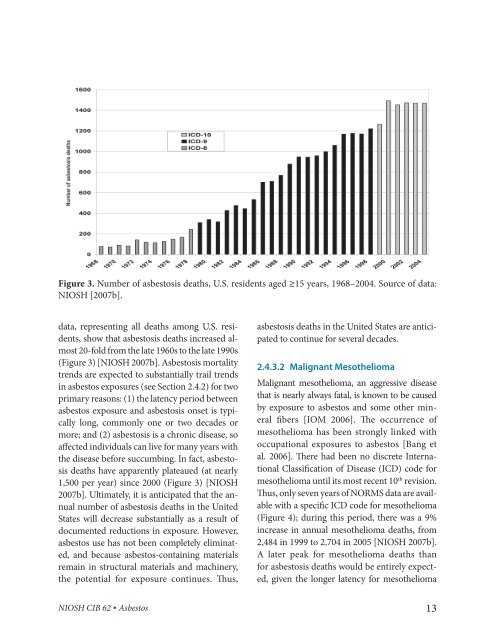Asbestos Fibers and Other Elongate Mineral Particles: State of the ...
Asbestos Fibers and Other Elongate Mineral Particles: State of the ...
Asbestos Fibers and Other Elongate Mineral Particles: State of the ...
- No tags were found...
Create successful ePaper yourself
Turn your PDF publications into a flip-book with our unique Google optimized e-Paper software.
Figure 3. Number <strong>of</strong> asbestosis deaths, U.S. residents aged ≥15 years, 1968–2004. Source <strong>of</strong> data:<br />
NIOSH [2007b].<br />
data, representing all deaths among U.S. residents,<br />
show that asbestosis deaths increased almost<br />
20-fold from <strong>the</strong> late 1960s to <strong>the</strong> late 1990s<br />
(Figure 3) [NIOSH 2007b]. <strong>Asbestos</strong>is mortality<br />
trends are expected to substantially trail trends<br />
in asbestos exposures (see Section 2.4.2) for two<br />
primary reasons: (1) <strong>the</strong> latency period between<br />
asbestos exposure <strong>and</strong> asbestosis onset is typically<br />
long, commonly one or two decades or<br />
more; <strong>and</strong> (2) asbestosis is a chronic disease, so<br />
affected individuals can live for many years with<br />
<strong>the</strong> disease before succumbing. In fact, asbestosis<br />
deaths have apparently plateaued (at nearly<br />
1,500 per year) since 2000 (Figure 3) [NIOSH<br />
2007b]. Ultimately, it is anticipated that <strong>the</strong> annual<br />
number <strong>of</strong> asbestosis deaths in <strong>the</strong> United<br />
<strong>State</strong>s will decrease substantially as a result <strong>of</strong><br />
documented reductions in exposure. However,<br />
asbestos use has not been completely eliminated,<br />
<strong>and</strong> because asbestos-containing materials<br />
remain in structural materials <strong>and</strong> machinery,<br />
<strong>the</strong> potential for exposure continues. Thus,<br />
NIOSH CIB 62 • <strong>Asbestos</strong><br />
asbestosis deaths in <strong>the</strong> United <strong>State</strong>s are anticipated<br />
to continue for several decades.<br />
2.4.3.2 Malignant Meso<strong>the</strong>lioma<br />
Malignant meso<strong>the</strong>lioma, an aggressive disease<br />
that is nearly always fatal, is known to be caused<br />
by exposure to asbestos <strong>and</strong> some o<strong>the</strong>r mineral<br />
fibers [IOM 2006]. The occurrence <strong>of</strong><br />
meso<strong>the</strong>lioma has been strongly linked with<br />
occupational exposures to asbestos [Bang et<br />
al. 2006]. There had been no discrete International<br />
Classification <strong>of</strong> Disease (ICD) code for<br />
meso<strong>the</strong>lioma until its most recent 10 th revision.<br />
Thus, only seven years <strong>of</strong> NORMS data are available<br />
with a specific ICD code for meso<strong>the</strong>lioma<br />
(Figure 4); during this period, <strong>the</strong>re was a 9%<br />
increase in annual meso<strong>the</strong>lioma deaths, from<br />
2,484 in 1999 to 2,704 in 2005 [NIOSH 2007b].<br />
A later peak for meso<strong>the</strong>lioma deaths than<br />
for asbestosis deaths would be entirely expected,<br />
given <strong>the</strong> longer latency for meso<strong>the</strong>lioma<br />
13

















